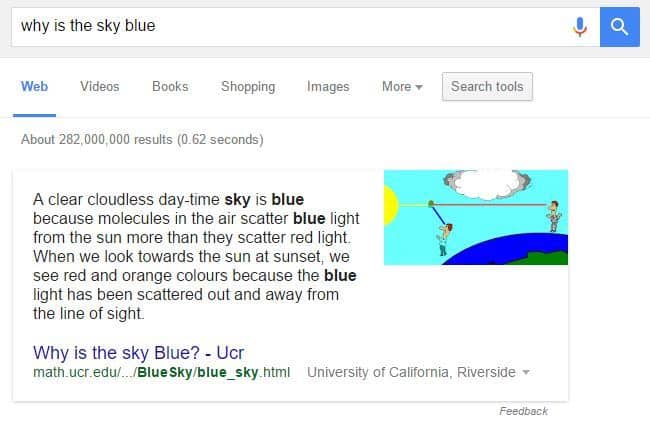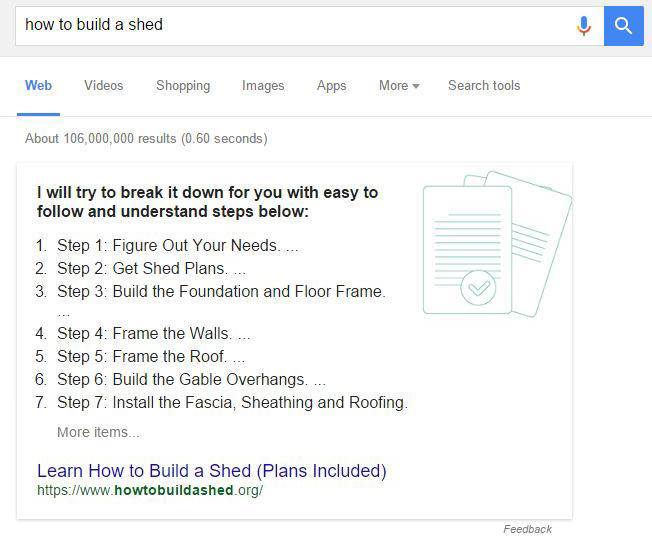
The Google Quick Answer Box: What, Why and How?
While not new, the Google Quick Answer box remains a highly under-utilized tool by companies looking to get their content (and their websites) found by web searchers. As you wrap up one campaign and firm up your SEO and marketing plans for the next one, you should take a moment to consider putting the Google Quick Answer box to work for you.
What Is the Google Quick Answer Box?
Before we launch into things too much, let’s step back and briefly review exactly what this Google Quick Answer box is. In its purest form, the Quick Answer box is Google’s way of giving people the information they need as quickly and as easily as possible.
It is comprised of content that is taken from a website that directly answers the question that was asked by the searcher, along with a link to the site on which the content resides. While this is mostly copy, it can include an image and some Quick Answer boxes now are providing explicit calls to action to get more information. All of this literally appears in a box on a SERP page above all other organic search results.
Is The Google Quick Answer Box Good or Bad?
From a user perspective, the Quick Answer box is like a breath of fresh air. You’ve probably benefitted from it yourself. I know that I have. You have a relatively simple question that you want a quick answer for. You type that question into Google and immediately are presented with the answer—without any need to click through to a page where you may be forced to become a virtual detective to actually find the information.
From a business perspective, there can be a concern—understandably so—that the Quick Answer box could actually hamper your ability to get people to click through to your site because they no longer have any need to do so. You—via Google—have already given them what they need. However, I would argue that such a view is a very shortsighted one.
First of all, once people have seen your link and name in the Quick Answer box, you have already succeeded in achieving a valuable impression. On top of that, the person may well have a need or desire to know more and if your site successfully answered their initial query, your chances of getting the click-thru just went up.
Another important fact to point out is that you do not have to have a #1 ranked page in order for your content to appear in a Quick Answer box. For small or medium-sized companies, this can be a valuable opportunity to compete against the big guys for mindshare and visibility.
How do You Optimize Content for the Google Quick Answer Box?
Content that appears in a Quick Answer box must be of high authority and directly relevant to the theme of a query. The content itself must be structured in a very organized manner with the user experience the clear priority. In short, the content must clearly and succinctly answer a specific question.
With this in mind, the creation of a Q&A section on your website (there are many ways to do this – see below) is the #1 way to go after the box position. Answers to questions are what Google—and users—want, so why not give them answers in the most basic and straightforward way possible? Google (obviously) loves that sort of thing.
Depending upon your industry, a selection of how-to guides may be appropriate for this purpose – or maybe a small section in each blog devoted to answering a singular question. In other cases, a Q&A section can be utilized and should focus on educating people about different concepts. Either way, here are four strategies to help maximize the effectiveness of creating content for the Google Quick Answer Box:
1. Multi-page Structure
When we say “Q&A section” we don’t necessarily mean a FAQ with all questions and answers on one page. When choosing a Multi-page Structure your Q&A should be segmented out by topics or themes with individual questions and answers having their own pages. Consider calling out the most popular or newest questions to further group topics.
2. Individual Page Links
With this strategy each page is devoted to one question and answer should include multiple links. One link should be to your primary service or product page, one as a CTA and others to additional relevant resources.
3. Q&A Page Content
“How to” pages should be set up in bullet or step-by-step format. Pages that answer other question formats like “What is” must be equally logical and structured even if sans bullets. All must be easily digestible in a short amount of time.
4. On-page SEO
Attention must be given to this including the use of words like “how”, “what” or “definition” in the title tag, H1 and URL. Where possible, the URL should contain the full query. You can think of these terms as your keywords in a way.
When developing topics, certainly you can rely on your own industry, business and customer knowledge to a large degree. You are the expert in your area, after all. But, do not let that be the end of your topic search. Leverage your site’s internal search and stay abreast of changes or trends that could signal the need for new Q&A topics.
It is equally important that you make your Q&A pages findable. An XML sitemap, an HTML sitemap and a Schema markup will all be huge assets for you in this effort. Anything that helps bots scan your content in the least amount of time should be done.
Why Wait? Utilize the Google Answer Box Today
The Google Quick Answer box is here to stay, at least for the foreseeable future, so why not take advantage of it now? As you look into this, you might be pleasantly surprised to find that you actually have a lot of content ready for Q&A structure already on your site. Don’t feel that you have to recreate the wheel, especially to get started. Leverage existing assets and build out from there. You’ll be glad you did.
- The Google Quick Answer Box: What, Why and How? - December 20, 2023
- Top 10 Link-Building Strategies for Content Marketers - July 12, 2023
- 8 Types of Ecommerce Content You Should Start Using - May 15, 2023




